Scirpus longii is a species of flowering plant in the sedge family known by the common name Long's bulrush. It is native to eastern North America, where it is limited to the Atlantic coastal plain.

Muhlenbergia capillaris, commonly known as the hairawn muhly, is a perennial sedge-like plant that grows to be about 30–90 cm (0.98–2.95 ft) tall and 60–90 cm (2.0–3.0 ft) wide. The plant includes a double layer; green, leaf-like structures surround the understory, and purple-pink flowers outgrow them from the bottom up. The plant is a warm-season grass, meaning that leaves begin growth in the summer. During the summer, the leaves stay green, but they morph during the fall to produce a more copper color. The seasonal changes also include the flowers, as they grow out during the fall and stay healthy till the end of autumn. The muhly grows along the border of roads and on plain prairies. The grass clumps into herds, causing bush-like establishments in the area the hairawn muhly inhabits. The flowers are very feathery and add a cloudlike appearance to the top of the grass. It is native to eastern North America and can be used for a multitude of purposes, including ornamental gardening and farming. It was voted 2012 plant of the year by the Garden Club of America.
Carex cumulata, common names clustered sedge, piled sedge, and piled-up sedge is a species of Carex native to North America. It is a perennial.

Carex siccata, also referred to as Carex aenea and Carex foenea, common names include bronze sedge, dry land sedge, Fernald's hay sedge, hay sedge, and hillside sedge, is a species of Carex native to North America. It is listed as extirpated in Pennsylvania, endangered in New Jersey, North Carolina, Ohio and Vermont, threatened in Maine and Tennessee, special concern in Connecticut, and sensitive in Washington (state).
Carex reznicekii, known as Reznicek's sedge, is a species of Carex native to North America. It is a perennial.
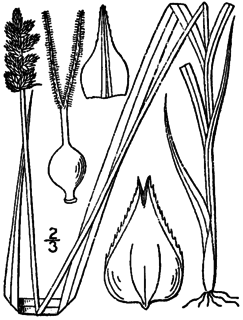
Carex alopecoidea, common names foxtail sedge and northern fox sedge, is a species of Carex native to North America. It is listed as threatened in Connecticut. It is listed as endangered in Indiana, New Jersey, Ohio, as possibly extirpated in Maine, as threatened in Massachusetts, and as endangered and possibly extirpated in Tennessee.
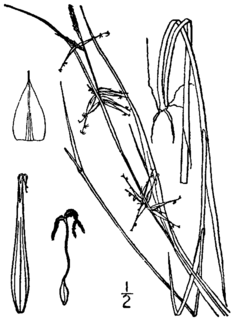
Carex collinsii, common name Collins' sedge, is a species of Carex native to North America. It is listed as a special concern species and believed extirpated in Connecticut. It is listed as endangered in New York, as threatened in Pennsylvania, and its historical range included Rhode Island.
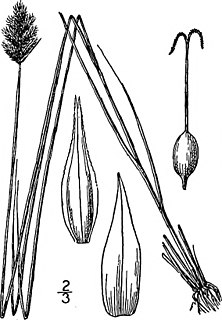
Carex crawfordii, common name Crawford sedge, is a species of Carex native to North America.
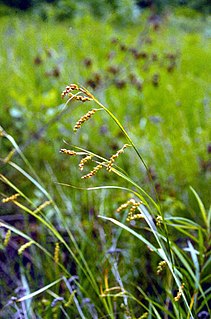
Carex davisii, known as Davis' sedge or awned graceful sedge, is a species of Carex native to North America. It is listed as an endangered, threatened, or species of concern across much of edge of its range. It was named in the 1820s by Lewis David de Schweinitz and John Torrey in honor of Emerson Davis (1798–1866), a Massachusetts educator and "enthusiastic student of the genus" Carex.
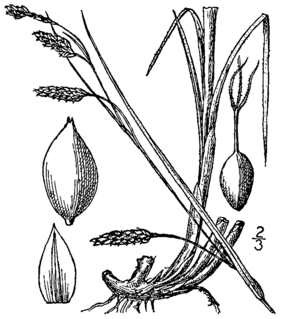
Carex formosa, sometimes called handsome sedge, is a species of sedge that is native to North America. It is listed as an endangered species in Minnesota, New Jersey, and Pennsylvania, as threatened in Connecticut, Massachusetts, New York, and Wisconsin, and as presumed extirpated in Ohio.

Carex magellanica, or the boreal bog sedge, is a Carex species that is native to North America. It is listed as endangered in Connecticut.

Carex novae-angliae, the New England sedge, is a Carex species that is native to North America.

Carex oligocarpa, common name richwoods sedge, eastern few-fruited sedge, few-fruit sedge, and few-fruited sedge is a Carex species that is native to North America. It is a perennial.

Carex oligosperma, common name fewseed sedge, few-seeded sedge, and few-fruited sedge, is a perennial plant in the Carex genus. A distinct variety, Carex oligosperma var. oligosperma, exists.

Carex polymorpha common names variable sedge and many forms sedge, is a perennial species of Carex native to North America.

Carex prairea, common name prairie sedge, is a species of Carex native to North America. It is a perennial.
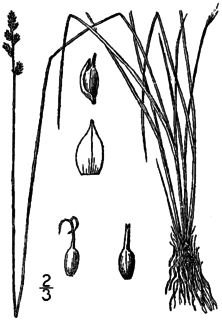
Carex sterilis, common names dioecious sedge, sterile sedge and Atlantic sedge, is a perennial plant native to North America.

Carex typhina, common name cattail sedge, is a species of Carex native to North America.

Carex viridula, known as little green sedge, green sedge, or greenish sedge, is a small flowering plant native to North America, Europe, Asia, and Morocco.

Carex willdenowii, common name Willdenow's sedge, is a species of Carex native to North America.

















